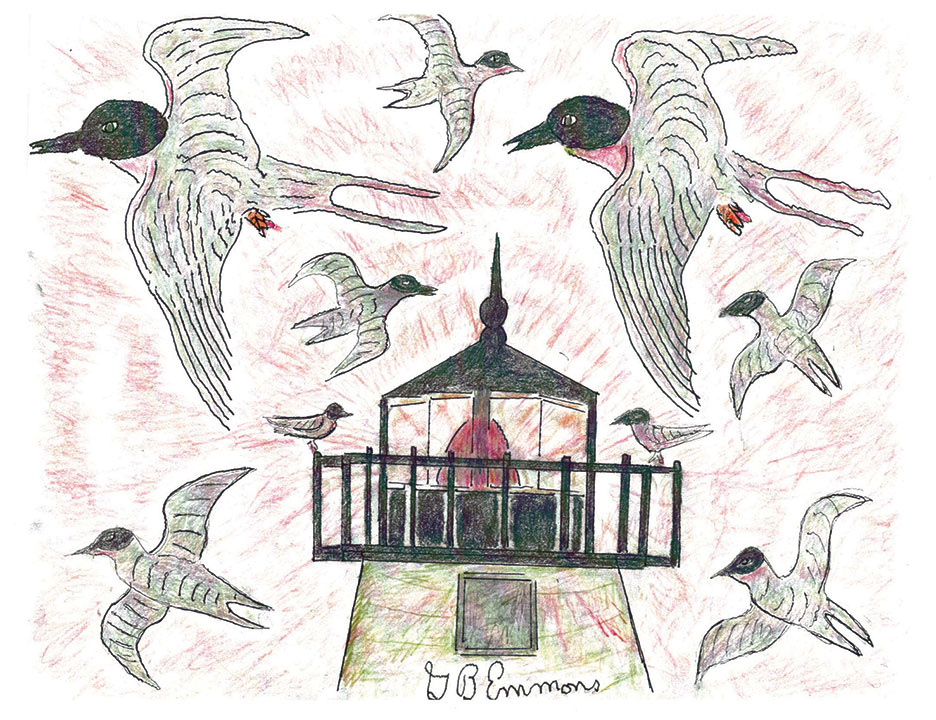Bird Island Lighthouse stands as an obsolete landmark at the mouth of Marion Harbor, that in modern times has found to be a valuable nesting site for two species of endangered Terns.
Now owned and operated by the town itself, the lighthouse was built in 1819 for safe shipping traffic in and out of the harbor. With the coming of the 19th-century industrial revolution in New England, traffic for the trading of manufactured products was paramount for safe passage from and to many other ports. Then the assignment of a lighthouse keeper was essential for in-house caretaker of its operation, particularly in foul weather. High winds, rough seas, and hazardous duty to rescue ship-wrecked victims was an ongoing possibility.
My wife’s great grandfather, Richard Pinkham, was at that time the first lighthouse keeper on Nantucket Island. He was also the first keeper to chart the waters around Nantucket, Martha’s Vineyard, and Block Island. Perhaps this was his foresight to avoid the consequences of poor-navigation, trial and error of safe passage through the shoals by way of the channel.
Like Nantucket, Marion Harbor is tricky to maneuver particularly in choppy seas. The lighthouse stands on an acre and a half in the channel itself, and for sailing vessels with heavy cargo the traditional prevailing breeze was helpful, but also unpredictable towards the hurricane season.
In September of 1938, the unpredicted hurricane of more than 120 mile an hour winds brought a tidal surge of more than 15 feet over the island. The keeper’s residence, oil shed, and a boathouse were all washed away, except for the tower structure itself. The light was decommissioned in 1935 and remained so until 1996, now owned and preserved by the town. A town committee was formed as a Bird Island Restoration effort that successfully relit the beacon in 1997, after 62 years of darkness at the head of Marion’s previously historic but changing to recreational boating traffic.
However, in the meantime, the location of the island at this focal funnel of a seasonal wind tunnel from Buzzards Bay into waters of Cape Ann, had for years become a traditional nesting site along the Atlantic migrational flyway for both the Roseate and Common Terns previously mentioned.
Perhaps the landmark tower was seen on the thousand-mile or more journey from the West Indies as a recognizable destination marker for a rocky shoreline of nesting sites. Together the arrival of 3,500 pairs annually accounts for 25 percent of declining national population. As illustrated, the Roseate is among the most beautiful and elegant of the two, with a black head and faintly tinted, rose-colored underbody. It has a distinctive, long split tail that flutters in flight, along the trailing edge of its plumage.
The Common Tern is lesser in numbers, but easily distinguished by a dark wedge on the outer three of its five primaries. For years both their numbers have shown a consistently serious decline. The present stewardship by the Marion Harbormaster caretaking in support by the U.S. Fish and Wildlife conservation efforts bore remarkable fruit last year with the gift of more than 500 new nesting boxes for the island.
It is truly remarkable that a historic symbol of maritime and occupational images of billowing seas and three-masted schooners should be rescued for future generations by coming to grips with environmental awareness. The light itself will operate from Memorial Day to Labor Day, with a solar heartbeat timer to show the way, out of the past, into the future.
By George B. Emmons
